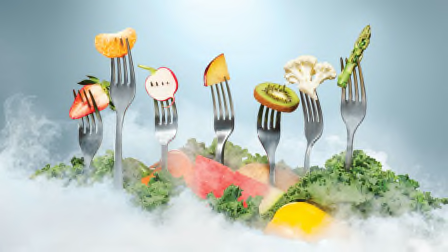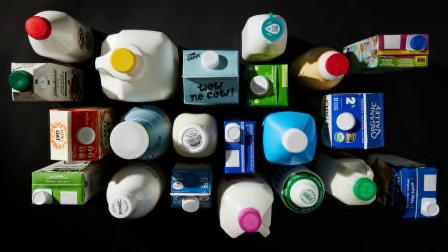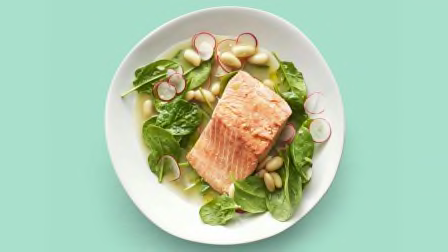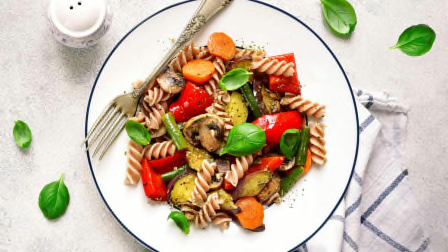The Ideal Diet for Lower Blood Pressure
Eating lots of whole foods—and watching the sodium—can help reduce your need for medication
When you shop through retailer links on our site, we may earn affiliate commissions. 100% of the fees we collect are used to support our nonprofit mission. Learn more.

High blood pressure (aka hypertension) affects 1 in 3 Americans. Medication can help control it, but as with most chronic health conditions, having healthy habits is also important.
“You should always work with your doctor, but lifestyle can play a huge role in managing hypertension at every age,” says Holly Nicastro, Ph.D., M.P.H., program director in the division of cardiovascular sciences at the National Heart, Lung, and Blood Institute. That includes not smoking, controlling stress, exercising, and eating the right kinds of foods. In fact, a healthy diet is one of the most powerful tools for lowering your numbers—and may reduce the need for medication.
The DASH Diet
The effect of diet on hypertension has been extensively studied.
“There are many different diets with purported benefits for high blood pressure, but DASH has the strongest base of evidence,” says Stephen Juraschek, M.D., Ph.D., an assistant professor at the Harvard Medical School who focuses on cardiovascular disease.
DASH, which stands for Dietary Approaches to Stop Hypertension, includes fruits and vegetables (8 to 10 servings a day), whole grains, beans, nuts, low-fat dairy, lean meat (such as poultry and seafood), and healthy fats. It limits red meat, added sugars, and unhealthy fats.
Skip the Shaker
The experts we interviewed emphasize the importance of a lower-sodium diet for reducing blood pressure. For example, a 2001 study in The New England Journal of Medicine found that limiting sodium and following a DASH diet resulted in even bigger reductions in blood pressure than doing DASH alone.
“There’s reason to believe [eating a lower-sodium diet] should work for most people,” Juraschek says. The daily sodium recommendation is less than 2,300 mg. Ask your doctor whether going lower might be beneficial for you.
Get out of the habit of salting your food, but also remember that more than 70 percent of sodium intake comes from packaged and prepared foods. “Bread and rolls are the No. 1 source of sodium in the American diet,” Juraschek says. “Just 2 teaspoons of salad dressing can have a quarter of the recommended amount of sodium.” And restaurant food is a huge source of sodium. Even seemingly healthy menu items, like salads or chicken, may contain higher amounts of sodium than those prepared at home.
Pressure-Friendly Foods
“You really have to look at the overall eating pattern [such as DASH] that you’re following, not individual foods by themselves,” says Alice H. Lichtenstein, D.Sc., director of the Cardiovascular Nutrition Laboratory at the Jean Mayer USDA Human Nutrition Research Center on Aging at Tufts University. “That’s what will make the biggest difference.” Still, when you’re deciding what to include as part of a healthy diet, consider adding the following to your grocery list. Even though their effect on blood pressure may appear small (just 2 points, in some cases), that can still have an impact on your risk of heart attack and stroke.
Beans, peas, and lentils. High in fiber and potassium, these have been shown to lower blood pressure. A 2018 study in the journal Nutrients found that when adults increased their fiber intake (from cereal and vegetables, including beans) from 5 grams to 25 grams a day, their risk of hypertension dropped by 53 percent.
Blueberries. The anthocyanins in these berries, which give them their vibrant hue, may help enhance blood vessel function, lowering pressure. A recent study in the Journals of Gerontology, Series A, found that consuming them daily for a month resulted in a 5-point drop in blood pressure.
Flaxseed. In a 2015 review of research published in The Journal of Nutrition, supplementing with flaxseed (which contains anti-inflammatory omega-3 fatty acids, among other healthy nutrients) for more than three months helped reduce both systolic and diastolic blood pressure by almost 2 points each.
Olive oil. Some studies have linked extra virgin olive oil, which is rich in healthy plant compounds, with reduced systolic blood pressure (as well as other heart disease risk factors). It’s still high in calories (120 calories per tablespoon), so use it in place of butter or other less healthy fats.
Pumpkin seeds. Some preliminary research has shown that pumpkin seeds (aka pepitas), which contain fiber and magnesium, and pumpkin seed oil may help reduce blood pressure. Opt for the unsalted kind, and nibble them as a snack or toss them into dishes made with whole grains or on top of salads.
Spinach. A 2015 study in the journal Clinical Nutrition Research showed that nitrate-rich spinach helps relax blood vessel walls, and supplementing with it over a one-week period reduced systolic blood pressure by slightly more than 3 points and diastolic by more than 2 points. (Beets are also high in nitrates.) Spinach and other leafy greens, such as Swiss chard, are also high in potassium, which helps to counteract the effects of sodium.
Yogurt. A large 2018 study, in the American Journal of Hypertension, found that for people with high blood pressure, eating two or more servings of yogurt a week was linked to a 17 percent lower risk of being diagnosed with cardiovascular disease for women and a 21 percent lower risk for men, compared with those who ate it less than once a month. The researchers noted that it may not only be the calcium that contributes to the heart-protective benefits of yogurt but also the bacteria from fermentation. Choose plain yogurt over sweetened, and add fruit for sweetness if you like.
Exercise Your Way to Lower Numbers
Diet isn’t the only nondrug strategy for lowering your numbers. A 2017 review of 53 studies involving older adults, in the Journal of the American Society of Hypertension, found that both aerobic exercise and strength training lowered blood pressure by 5 systolic and 3 diastolic points. The American College of Sports Medicine recommends 30 minutes of moderate-intensity aerobic exercise (a level where you can maintain a conversation) on most days and targeting your entire body with weights at least twice a week.
A type of training called isometrics has shown potential for reducing blood pressure. Traditional strength training involves lifting and lowering weights or otherwise moving your joints during a routine. With isometrics, you maintain one position with the muscles contracted—think planks, wall sits, and holding weights in each hand out to your sides. (Isometrics builds muscle but not as effectively as strength training does.)
If you have hypertension, ask your doctor for a referral to an exercise program that’s designed to improve heart health. Hospitals, community centers, and YMCAs may have programs.
Below you'll find the top home blood pressure arm and wrist monitors from Consumer Reports' tests.
Editor’s Note: This article also appeared in the November 2019 issue of Consumer Reports On Health.




















